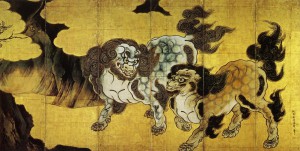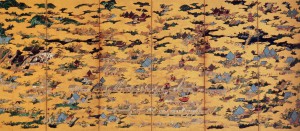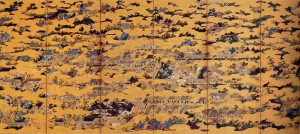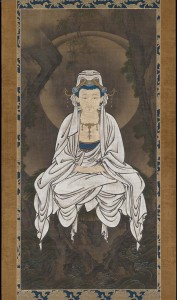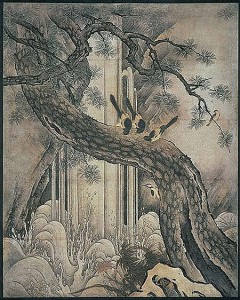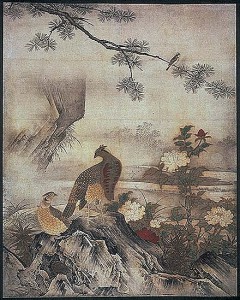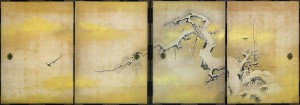Kanou School / Schools of Nihonga 002
Kanou School / Kanou-ha
Kanou school is a school of painting from the mid-Muromachi period to the early Meiji period that follows the lineage of the *Chinese-style painting. It was founded by Kanou Masanobu (1434-1530) who became the official artist for the shogunate. Kanou School established its style as a leading school of painting by fusing the Chinese-style painting and *yamato-e painting. The screen or wall painting in gold with its rich colors and expressions using sumi ink reflects the taste of those days well and may be said to be the most representative style of expression of Kanou School. Motonobu (1476-1559), the eldest son of Masanobu, established the foundation for the development of Kanou School in terms of new painting styles and management of studios. Eitoku (1543-90), Masanobu’s grandson, produced luxurious and splendid screen or mural paintings in the castles which were very important under the goverment Oda and Toyotomi.
*Chinese-style painting / Kanga:
“Kanga” refers to a style of painting of the medieval and modern periods, and also to the paintings themselves, that follow the painting style of the Song and Yuan dynasties in China. At first it was called kara-e, but after the Edo period the term kanga began to be used in order to distinguish it from Chinese paintings of earlier times. Chinese style painting is in direct contrast conceptually to Yamato-e painting. Whereas in Yamato-e, the painting style of the Tang dynasty has been Japanized to reflect the aesthetic sense and themes particular to Japan, the Chinese-style painting is an imported painting style that is based on Chinese painting techniques. The lineage of the Chinese-style painting was inherited by Takuma School and Kanou School. Merging with the yamafo-e painting, the Chinese-style painting developed into an expression of an aesthetic awareness distinctive to Japan.
*Yamato-e painting:
In the latter half of the 9th century, during the Heian period, as court culture became more Japanized, paintings depicting scenery characteristic of Japan began to appear in response to the demand for paintings that express Japanese sentiments. From about the end of the 10 th century, this kind of painting, inheriting the style of the Heian period, began to be called yamato-e, to distinguish it from the Chinese painting/Chinese-style painting (later known as kanga), or paintings with Chinese themes that were influenced by Song and Yuan painting styles. The style of the yamafo-e painting was transmitted through edokoro (official bureau of painting) which had been in charge of court paintings since the Heian period. When the Tosa family inherited the administration of the edokoro (the courtly office for paintings) in the Muromachi period, the word yamato-e began to be used to refer not only to themes and style, but also to the concepts of the Tosa School.
After the Edo period, Tanyuu (1602-74), Eitoku’s grandson, became the official artist for the Tokugawa shogunate and established the largest school organization. Although family lineage and rank were maintained by inheritance, because it continued to provide artistic training based on the principles of the model painting, Kanou School style gradually lost its creative character. Unkoku School, Hasegawa School and Kaihou School, rival schools of Kanou School, produced outstanding works of art and continued into the Edo period. The most representative works of Kanou School are Motonobu’s screen or wall paintings at Daisen-in of Daitokuji temple, Eitoku’s screen or wall paintings at Jukou-in of Daitokuji temple, and Tanyuu’s meticulously studied and reduced-size copies of traditional paintings known as Tanyuu shukuzu.

